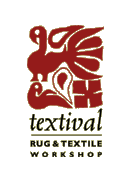|
|
|

|
| Care
and Maintenance Index |
||
| Display/Storage |
||
| . |
||
| Use
the Index
buttons to return |
||
Storage
When a rug or textile is to be placed into storage
for more than two or three months, it should first be cleaned to discourage
insect infestation. Make sure someone is able to inspect wool rugs and
textiles several times a year for moths and other condition problems.
Roll the item instead of folding, as some creases can cause permanent
damage and are difficult to remove. Make sure the item is only in contact
with acid-free surfaces, tubes, and wrapping. Never seal the item in plastic
for more than a few weeks, as moisture that may have been absorbed into
the wool fibers can build up as condensation, promoting mildew. An acid-free,
water resistant, air-permeable wrapping like ‘Tyvek” is preferred.
Never store a rug directly on a concrete floor, as moisture can be drawn
into the rug over time. Choose a storage location that is protected from
flooding and is not subject to extremes of heat, cold or humidity.
Index
Mounting/display
If you choose to display a rug or textile vertically or on a wall, the
primary concern is the even support of the warp and weft or other structure
of the item. Serious damage can result from nails and pins, stretching
and sagging from uneven support, use of improper hardware and materials,
and strain on unprotected fragile areas. Consulting a conservator is always
recommended before attempting a mounting treatment yourself, and you may
choose to have an experienced professional do the work for you, especially
if the item is fragile or has a high value. Mounting costs are typically
reasonable.
Mounting
is done either with or without a frame-work, depending on the needs of
the piece.
Frame-work, or hard mounting:
This involves stretching a washed linen or cotton fabric over a sealed/treated
stretcher bar, then carefully stitching the textile to the linen, making
certain the piece is evenly supported across its entire area. This technique
is recommended for light-weight and fragile textiles that should not hang
of their own weight, and provides the best protection for a textile. The
only drawbacks are that only one side of the textile can be viewed, and
larger textiles on hard frames can be unwieldy to move. Also, some distortion
often results from laying the piece flat.
Non-frame-work
hanging methods include:
Soft-mount fabric backing: When a textile is fragile
and requires support, but its appearance is helped by its natural ‘drape’,
then a fabric backing can be applied. This is done the same way as hard-mounting
only without the frame. A sleeve, velcro, or hooks are then sewn into
the backing fabric so that the weight of the item is bourne by the fabric
and not the textile. The main drawback of this method is that damage can
still be done to the textile (and the sewing threads can pull or tear
the item) when it is moved or rolled.
Rod
and sleeve or loop tabs:
When the textile can support its own weight, a sleeve
or a series of looped tabs can be sewn to the back and hung on a rod.
This is only recommended when the warp threads are to run vertically,
and the fabric sleeve or loops are hand-sewn through the warps. It is
difficult to get a rug or textile to hang straight or flat with this method,
and you will have a rod and hanging hardware sticking out from behind
the textile.
Velcro:
For textiles that can support their own weight,
this method is the most common and the most versatile. The soft unhooked
strip of the velcro is first sewn to a strip of fabric, which is then
sewn to the textile (through the warps if possible). The second, more
rigid hooked strip of velcro is either glued or stapled to a wood strip
which is mounted to the wall. The textile can then be attached and removed
with ease, and can be adjusted to help it hang flat and straight.
Other
hardware:
All of the above methods require a decision as to
which side of the textile to have face out, and all must be un-done in
order to turn the item. Carpet-tacking-strips are often used but cause
great damage to the textile. The only quality hanging strip we have found
that does not cover part of the textile, is easy to use, and does the
least damage is manufactured by Dee Ann Menuez in Santa Fe (505-982-8632).
Prices run from $1.50 to $1.75 per inch, depending on the spacing of the
support pins.
Index
![]()

